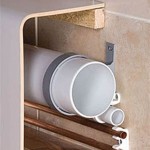Can You Use Big Tile In A Small Bathroom? Examining the Feasibility and Aesthetic Impact
The conventional wisdom often suggests that small bathrooms require small tiles. This notion stems from the idea that smaller tiles create the illusion of more space and are easier to manage within a confined area. However, contemporary design trends and a more nuanced understanding of spatial perception are challenging this belief. The question of whether one can effectively use large tiles in a small bathroom necessitates a thorough examination of various factors, including visual impact, installation considerations, and practical implications.
The size of tile used is not the sole determinant of a bathroom's perceived size. Factors such as color palette, grout line thickness, lighting, and overall layout all contribute to the spaciousness or lack thereof. Large format tiles, when implemented thoughtfully, can often enhance the perception of space, creating a visually seamless and uncluttered environment.
Visual Impact and Perception of Space
The primary argument against large tiles in small bathrooms centers around the idea that they overwhelm the space and make it feel even smaller. While this can be a valid concern if not executed carefully, the opposite effect is equally possible. Large tiles, due to their fewer grout lines, can create a cleaner, more continuous surface. This continuity tricks the eye into perceiving a larger, less fragmented space. The reduction in grout lines minimizes visual clutter, leading to a more streamlined and open feel.
The visual impact of large tiles is also closely tied to the color and pattern chosen. Lighter colors, such as whites and soft neutrals, are generally more effective at reflecting light and creating an airy atmosphere, which can be particularly beneficial in small bathrooms with limited natural light. Conversely, dark and overly busy patterns can visually shrink the space, regardless of the tile size. The use of large, plain tiles in a light color palette can therefore be a strategic approach to maximizing the perceived size of a small bathroom.
Furthermore, the alignment of tiles plays a crucial role in creating visual harmony. Laying large tiles in a vertical pattern can elongate the walls, making the ceiling appear higher. Horizontal layouts, on the other hand, can visually widen the space. Careful consideration of the room's dimensions and the desired effect is essential when deciding on the tile layout. Matching grout color to the tile color is another technique that further minimizes grout lines and creates a more seamless appearance.
Installation Considerations and Practical Implications
The installation of large format tiles presents specific challenges, particularly in a small bathroom. Cutting and maneuvering large tiles in a confined space can be difficult and time-consuming, potentially leading to increased labor costs. The accuracy of measurements and the precision of cuts are paramount, as even minor errors can become visually noticeable due to the tile's size. Professional installation is often recommended, as experienced installers possess the necessary skills and tools to handle large tiles effectively.
The substrate upon which the tiles are laid must be impeccably level and structurally sound. Large tiles are less forgiving of imperfections in the subfloor or wall surface. Uneven surfaces can lead to cracked tiles or uneven grout lines, compromising the overall aesthetic appeal and potentially causing structural issues. Proper preparation of the substrate, including leveling and reinforcement, is crucial for ensuring a successful and long-lasting installation.
Another practical consideration is the placement of fixtures and fittings. Large tiles may require adjustments to the placement of toilets, sinks, and other bathroom elements. The size and layout of the tiles should be carefully planned to avoid awkward cuts around these fixtures. It may be necessary to relocate plumbing or electrical wiring to accommodate the tile layout, which can add to the overall project cost and complexity.
Waste management is also a significant factor. Cutting large tiles inevitably generates a considerable amount of waste, which must be disposed of properly. The cost of waste disposal can add to the overall project budget, especially if special equipment or disposal methods are required. Efficient planning and careful cutting techniques can help minimize waste and reduce disposal costs.
Specific Design Strategies for Successful Implementation
Several design strategies can be employed to effectively integrate large tiles into a small bathroom environment. One approach is to use large tiles sparingly, focusing on specific areas such as the shower walls or the floor. This can create a focal point without overwhelming the entire space. Combining large tiles with smaller accent tiles can add visual interest and break up the monotony of a single tile size.
Another strategy is to opt for rectangular tiles instead of square tiles. Rectangular tiles can be used to create the illusion of greater length or width, depending on their orientation. Vertical installation of rectangular tiles can make the ceiling appear higher, while horizontal installation can widen the space. The choice of orientation should be based on the specific dimensions of the bathroom and the desired aesthetic effect.
The use of reflective surfaces can further enhance the perceived spaciousness of a small bathroom with large tiles. Mirrors, glass shower doors, and glossy tile finishes can all contribute to a brighter and more open atmosphere. Strategic placement of mirrors can visually double the size of the room, while glass shower doors create a seamless transition between the shower area and the rest of the bathroom. Glossy tiles reflect light, making the space feel brighter and more inviting.
Effective lighting is also essential for maximizing the impact of large tiles in a small bathroom. Proper lighting can accentuate the texture and color of the tiles, creating a more visually appealing environment. Recessed lighting, sconces, and vanity lights can be used to illuminate different areas of the bathroom, highlighting the tilework and creating a more balanced and harmonious space. A well-lit bathroom will invariably feel larger and more welcoming.
Finally, maintaining a minimalist aesthetic is crucial for preventing the space from feeling cluttered and cramped. Overly ornate fixtures, excessive accessories, and cluttered countertops can detract from the clean lines and visual continuity created by the large tiles. Opting for simple, streamlined fixtures and minimal accessories will help to maintain a sense of spaciousness and order.
Ultimately, the successful implementation of large tiles in a small bathroom hinges on careful planning, precise installation, and thoughtful design choices. While it may not be a universally suitable solution, when executed correctly, it can create a visually stunning and surprisingly spacious environment, defying conventional decorating norms.

Big Tile Or Little How To Design For Small Bathrooms And Living Spaces S Of America

Big Tile Or Little How To Design For Small Bathrooms And Living Spaces S Of America

Big Tile Or Little How To Design For Small Bathrooms And Living Spaces S Of America

How To Make A Small Bathroom Look Bigger With Tiles

Tiles Talk Find The Right Size For A Small Bathroom

Tiling A Small Bathroom Dos And Don Ts Bob Vila

19 Tricks To Make A Small Bathroom Look Bigger First Choice Warehouse

Choosing Tiles For A Small Bathroom Tile Wizards

Big Tile Or Little How To Design For Small Bathrooms And Living Spaces S Of America

10 Tile Ideas For Small Bathrooms And Cloakrooms Tiling Advice
Related Posts







